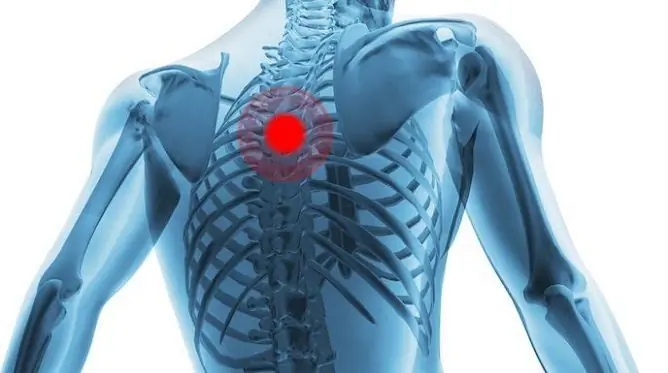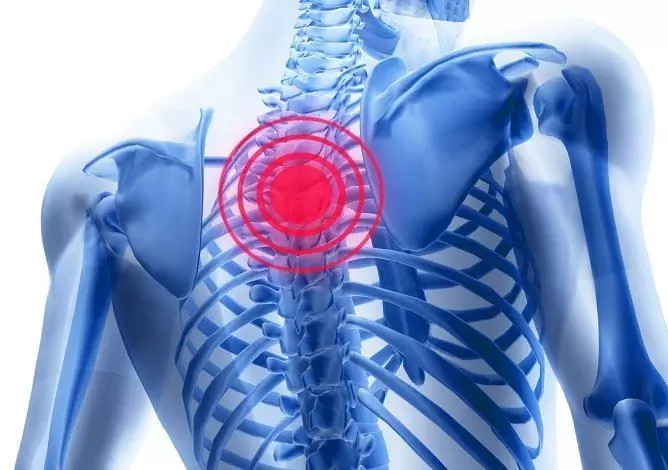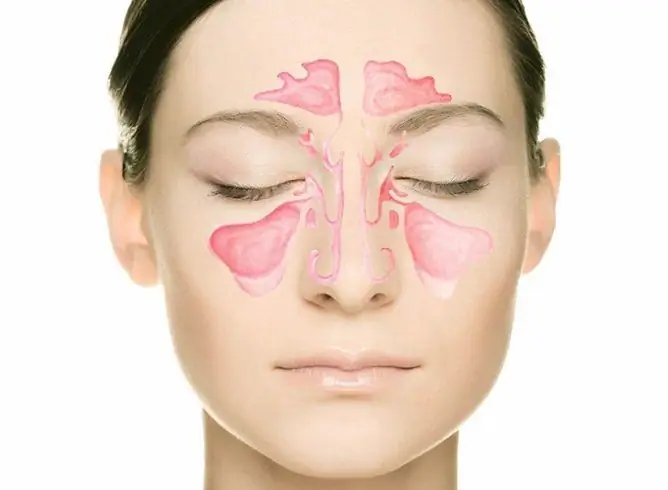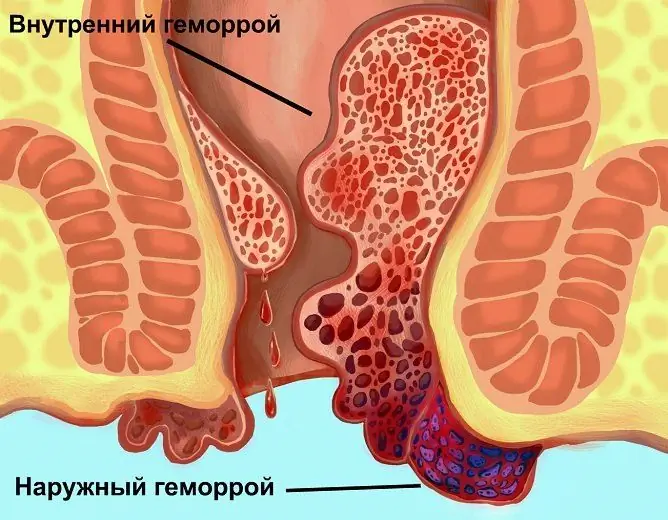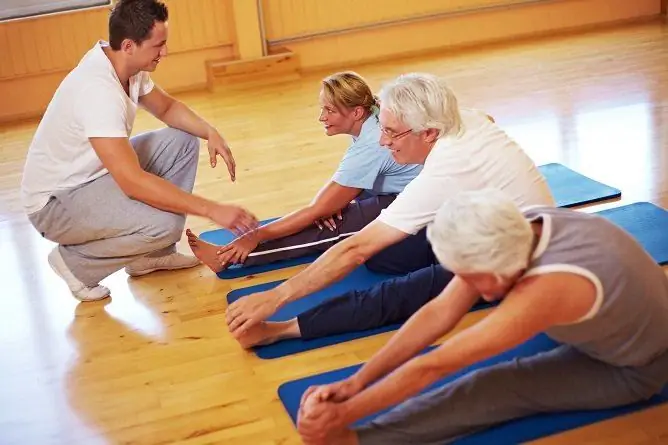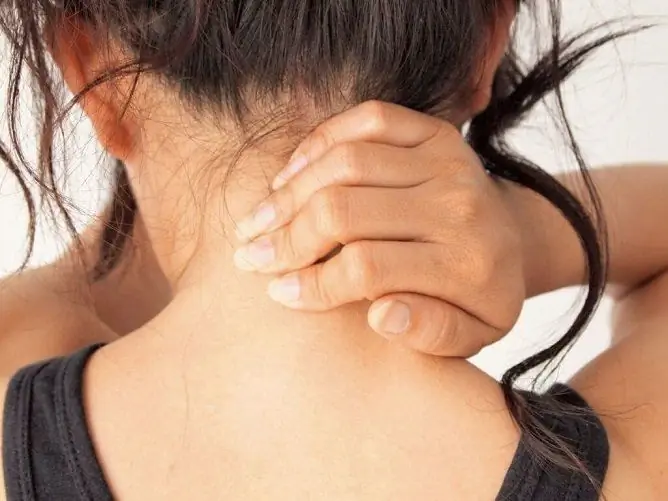- Author Rachel Wainwright [email protected].
- Public 2023-12-15 07:39.
- Last modified 2025-11-02 20:14.
Treatment of chest osteochondrosis at home
The content of the article:
- General approaches to treatment
-
Physiotherapy
- Principles of exercise therapy
- How to start remedial gymnastics
- A set of exercises
-
Drug therapy
- Chondroprotectors
- Pain relievers
- Muscle relaxants
- Vitamin preparations
- Lifestyle correction
- Folk remedies
- What you need to know about osteochondrosis of the thoracic spine and home treatment
- Video
Treatment of thoracic osteochondrosis at home consists of therapeutic exercises, massage, the use of medicines and folk remedies.
Spinal osteochondrosis is a degenerative-dystrophic disease in which the intervertebral discs are affected. Any part of the spine can be affected: cervical, thoracic, lumbar, sacral. Treatment can be carried out both in a hospital setting and at home - it depends on the severity of the symptoms and the stage of the disease.
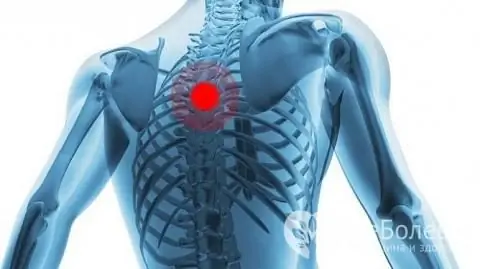
Home treatment of chest osteochondrosis should be carried out under the supervision of a physician, self-medication is unacceptable
General approaches to treatment
Treatment of osteochondrosis is always complex, regardless of whether a person is being treated - at home or in a hospital.
Main goals:
- Prevent further damage to the vertebrae and intervertebral discs.
- Relieve back pain.
- Relieve muscle tension in the affected segment.
- Improve the condition of the nervous tissue (nerve roots, which are impaired in osteochondrosis).
- Prevention of complications - the development of intervertebral hernia, compression of the spinal cord, radiculitis.
For these purposes, different methods of treatment can be used: surgery, medication, physiotherapy, therapeutic exercises, spinal traction, manual therapy, massage. At home, the range of possible therapeutic options is narrowing. At home, you can take medications prescribed by your doctor, do exercises and massage, use folk remedies, it is also extremely important to change your lifestyle.
Physiotherapy
Physiotherapy exercises (exercise therapy) is aimed at strengthening the muscle corset. With regular exercise, muscle tension disappears, blood circulation improves, and the anatomical structure of the spine is restored.
Principles of exercise therapy
- The main conditions for the effectiveness of exercise therapy are regularity, gradualness and painlessness.
- All exercises should be performed regularly, this is the only way to strengthen the muscles of the back and sternum. The exercises should be repeated 3 times a week.
- The duration of the workout is 30-40 minutes.
- It is necessary to gradually increase the load - the number of approaches or the strength of the execution.
- Exercise therapy should not cause strong pain. If pain occurs, stop the exercise immediately.
How to start remedial gymnastics
Before doing exercises to strengthen the muscles of the chest, it is imperative to do a general warm-up. It is necessary to warm up the muscles of the shoulder girdle and neck. Several general warm-up exercises:
- Starting position - standing, hands on the belt. It is necessary to alternately raise and lower either the right or the left shoulder. All movements must be performed slowly. The number of repetitions is 10 for each shoulder.
- Starting position - standing, hands on the belt. It is necessary to perform circular movements simultaneously with the right and left shoulder. It is important to ensure that your head does not tilt to your shoulder. The number of repetitions is 30 seconds back and forth.
- Starting position - standing on your knees and palms. The exercise consists of two parts: first you need to round your back and lower your head, return to the starting position, and then bend your back in the opposite direction.
- Starting position - lying on your back, knees pressed to your chest. The head must be bent to the knees, held in this position for 10 seconds, and then relaxed for 5 seconds. The number of repetitions is 10 times.
A set of exercises
After a general warm-up, you can proceed to a set of exercises aimed at strengthening the back muscles, restoring the mobility of the thoracic spine.
| No. | Initial position | Description | Number of repetitions |
| Lying on my stomach | Throw both hands behind your head, and spread your elbows wide to the sides. From this position, slowly lift the body. | 6 times | |
| Lying on my stomach |
How to do the exercise: · Fasten your hands in the lock and put them behind your back; · Bend the body; · Slowly raise the limbs up to the stop; · Stay in this position for 5 seconds. |
6 times | |
| Lying on my stomach |
The exercise consists of 2 parts: 1. Lying on your stomach, stretch your arms forward. Then slightly raise the body, stay in this position for 3 seconds and gradually lower down. 2. Starting position on the stomach, but arms are extended along the body. Raise the body again and hold for 3 seconds. |
4 times | |
| Sitting on a chair | Sitting on a chair, stretch both arms up and stretch well. Then put straight arms behind your back, arching your back. | 8 times |
Drug therapy
All medications are selected by the attending physician, self-medication is unacceptable. Chondroprotectors, non-steroidal anti-inflammatory drugs, muscle relaxants, vitamin preparations are prescribed.
For home use, topical tablets and ointments are generally recommended. Injections and injections are prescribed during the patient's stay in the hospital.
Chondroprotectors
Chondroprotectors are the only group of drugs that affect the mechanism of development of the disease, and not just its symptoms.
It makes sense to take drugs in the early stages of osteochondrosis, when the changes are reversible. Chondroprotectors affect the condition of the cartilage tissue, preventing damage to it.
What chondroprotectors can be taken at home:
- Arthouse;
- Protecon;
- Sanaflex;
- Teraflex;
- Arthron triactive forte.
Chondroprotectors are more effective when administered parenterally or intraarticularly. When taken orally, glucosamine and chondroitin sulfate are absorbed worse, which somewhat limits the use of chondroprotectors at home.
Pain relievers
Non-steroidal anti-inflammatory drugs (NSAIDs) are the main group of drugs that are prescribed to relieve pain in osteochondrosis. Local irritants and local anesthetics can also help manage pain. At home, pain relievers can be taken as pills, ointments, or patches.
| Release form | Application features | List of drugs |
| Pills |
Tablets are systemic agents. They are absorbed in the stomach, enter the general bloodstream and affect all organs and systems. In this regard, side reactions often develop: · Damage to the mucous membrane of the stomach and intestines; · Increased risk of cardiovascular disease; · Decrease in blood clotting; · Adverse effects on the liver and kidneys. The analgesic effect begins 20-30 minutes after application. |
Ketorolac (Ketalgin, Ketanov); Diclofenac (Dicloberl); Celecoxib (Celebrex); Meloxicam (Movalis); Etoricoxib (Arkoksia) Indomethacin (Metindol); Ibuprofen (Nurofen, Ibuprom). |
| Ointments, gels |
They have a local effect without being absorbed into the general bloodstream. In this regard, systemic adverse reactions during their use do not develop. With osteochondrosis, the ointment should be applied directly to the lesion focus (thoracic spine), and not to the place of pain irradiation. |
· Voltaren emulgel, Diklak gel; · Gel Artrocol, Ketoprom; · Nortafen, Dolgit cream, Nurofen; · Indovazin. |
| Plasters |
Pain relieving patches also work topically and rarely cause systemic adverse reactions. In this case, the development of local reactions is possible: Redness of the skin; Swelling; · Pain; Rashes. With their development, you must immediately remove the patch and rinse the affected area with water. The plasters are easy to use, the analgesic effect lasts for 12 hours. |
· Voltaren; · Ketotope; · Diclobene. |
Muscle relaxants
Muscle relaxants for osteochondrosis are prescribed to relax the muscles. Muscular hypertonicity occurs compensatory, as the body tries to protect itself from pain. The longer the duration of the illness, the more pronounced muscle tension.
For home use, centrally acting muscle relaxants are prescribed in the form of tablets:
- Baclofen;
- Midocalm;
- Midostad;
- Mioflex;
- Sirdalud.
The tablets are usually taken 2-3 times a day with meals. The doctor selects the dose individually, taking into account the severity of muscle tension and the presence of concomitant diseases. It is recommended to combine the intake of muscle relaxants with physiotherapy and therapeutic exercises.
Vitamin preparations
Vitamins for osteochondrosis are prescribed as an aid to the nervous tissue. Osteochondrosis of the thoracic spine often leads to compression of the spinal nerves. Clinically, this is manifested by paresthesia in the thoracic region (numbness, creeping feeling) and / or dysfunction of internal organs.
With osteochondrosis, B vitamins are prescribed, that is, preparations containing thiamine (B1), pyridoxine (B6) and cyanocobalamin (B12). For home use, tablet preparations are used:
- Neovitam;
- Milgamma;
- Neurobion;
- Neuroubin;
- Neuromax;
- Neurocobal.
Lifestyle correction
Therapeutic exercises and medications will only bring a temporary effect if a person does not change his lifestyle.
Observance of the following recommendations will help to get rid of osteochondrosis:
- It is better to sleep on a semi-hard or hard bed.
- For sedentary work, choose a chair with a comfortable back that you can lean against.
- Take breaks every 45 minutes of work. During the break, stretch your shoulders, chest and lower back.
- The height of the chair should correspond to the length of the lower leg (legs should rest on the floor).
- Avoid heavy lifting, sudden movements.
- Adhere to proper nutrition, give preference to fresh vegetables and fruits, cereals, poultry and fish, fermented milk products (especially important for women during menopause).
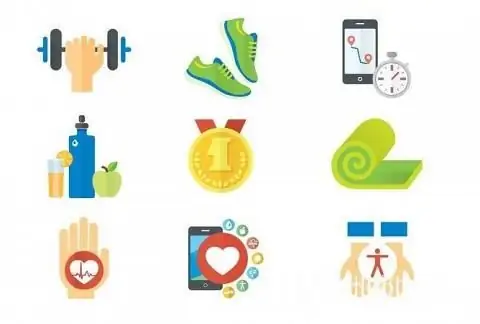
Only a change in lifestyle in a healthy direction will be able to provide conditions for the complete elimination of osteochondrosis
Folk remedies
Folk remedies for osteochondrosis can be taken as an additional treatment. They are divided into two groups - for indoor and outdoor use.
Folk remedies for internal use have analgesic and anti-inflammatory effects.
For the treatment of osteochondrosis can be used:
- Infusion of celery seeds. Recipe: 1 tbsp. l. seeds need to be poured with a glass of boiling water, left in a dark place for 2 hours. The infusion is taken in 1 tbsp. 3 times a day after meals.
- Mint decoction. Recipe: 1 tbsp. l. mint leaves you need to pour 2 glasses of water, boil in a water bath for 15 minutes. A decoction of 2 tbsp is taken. l. 4 times a day before meals.
- Infusion of ginger. Recipe: 1 tsp. chopped ginger root, pour 100 ml of water. The infusion is taken in 1 tbsp. l. after meal.
Folk remedies for external use can also be used - compress, lotions, rubdowns. For example, a warming compress. To prepare it you will need:
- 400 ml of vodka;
- 1 g of propolis;
- 50 g of aloe juice;
- 50 g mustard powder.
All ingredients must be mixed. The resulting solution is impregnated with tissue, which is then applied to the spine in the thoracic region (the place of greatest pain), and fixed on top with a woolen scarf. The compress can be left overnight.
What you need to know about osteochondrosis of the thoracic spine and home treatment
Thoracic osteochondrosis is a rather rare pathology. The first manifestations of the disease are often confused with the pathology of the heart, gastrointestinal tract, and respiratory system.
It will not be possible to quickly cure the disease, only long-term treatment is effective. You do not need to be limited only to home treatment, with an exacerbation of the disease, blockades, physiotherapy, and injections that cannot be performed at home are indicated.
Video
We offer for viewing a video on the topic of the article.

Anna Kozlova Medical journalist About the author
Education: Rostov State Medical University, specialty "General Medicine".
Found a mistake in the text? Select it and press Ctrl + Enter.

